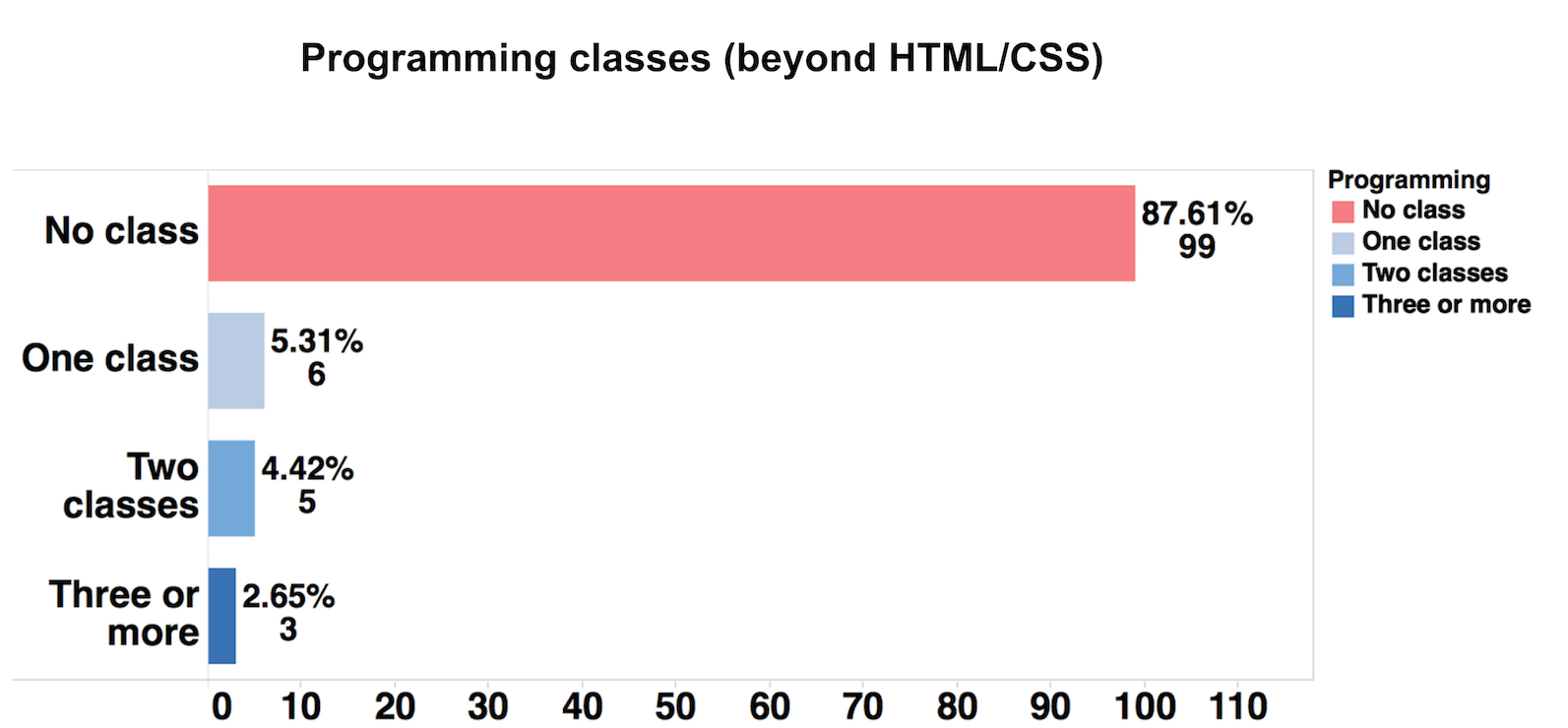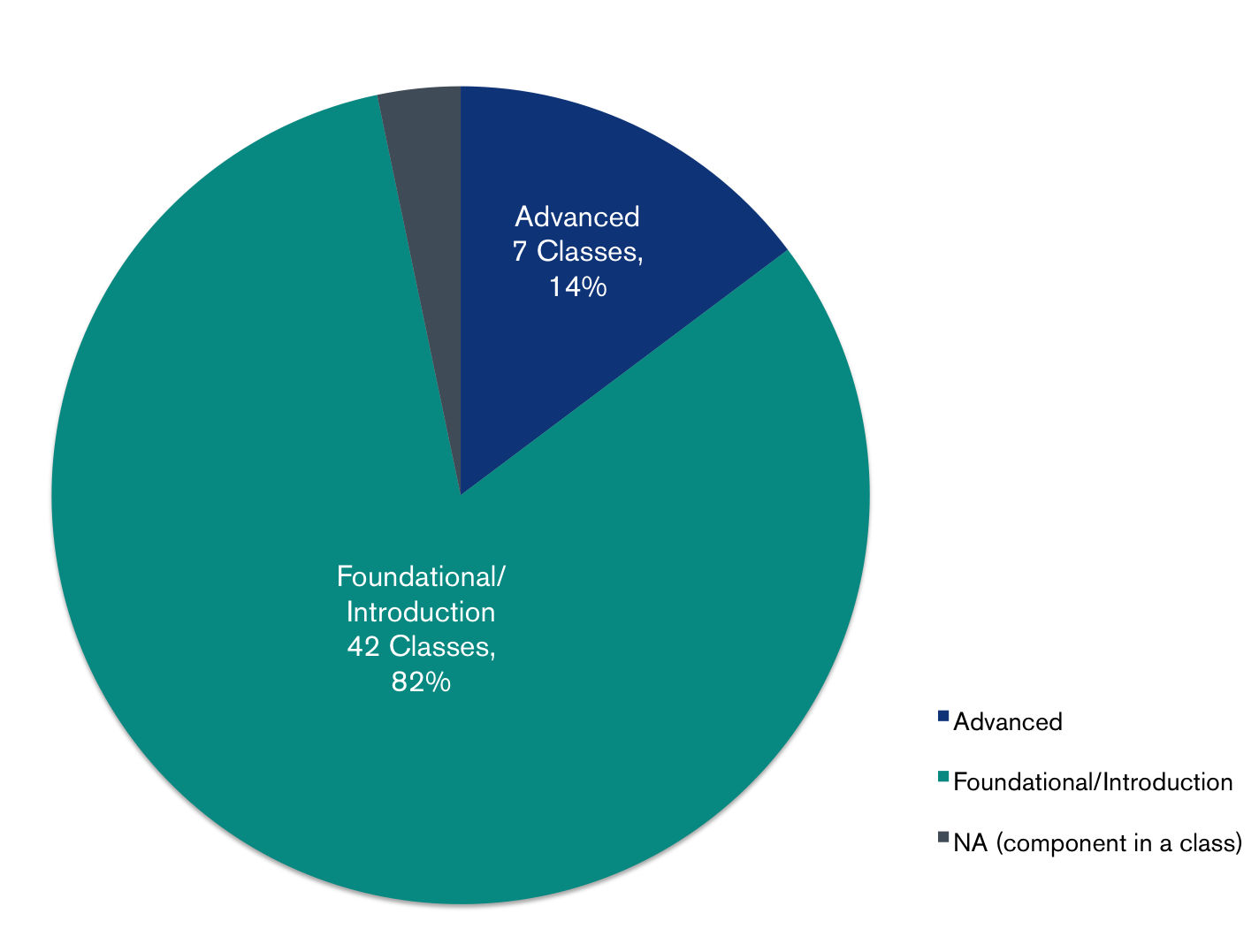Teaching Advanced Data Skills: Visualization and Programming
Advanced instruction in data journalism today is limited. Only 14 of the 113 AEJMC-accredited programs surveyed for this study teach programming beyond HTML/CSS to journalism students. And only 11 of the 113 offer coursework in emerging areas of data journalism, such as drones, virtual reality, and computational methods.

In fact, based on the analysis of syllabi and journalism programs, even some classes described as advanced primarily teach basic tenets of spreadsheet use. Part of the reason is that this is still where the need is greatest, said professors and trainers. “It is unbelievable how much time I spend teaching the basics,” said Jaimi Dowdell, the senior training director for IRE.
However, teaching the basic CAR curriculum is not enough, argued Kevin Quealy, a graphics editor at the New York Times and adjunct professor of journalism at New York University. “To do data work at a high level, one or two semesters of courses is very inadequate,” he said.
Many journalism programs offer design classes, but often those classes focus on basic design tenets, overall web design, or static infographics. Teaching students the concepts and skills needed to visualize data in an interactive way or to build a web application is more rare.

Not all data journalism educators are convinced that data visualization for news presentation should even be considered part of a data journalism curriculum. However, most agree that it is vital to teach visualization for the purpose of analysis. Alberto Cairo, who is leading an effort to fill a data visualization gap in his role as Knight Chair in Visual Journalism at Miami University, believes that even basic visualization instruction goes a long way toward literacy.
First, data journalists need to know how to do basic exploratory visual analysis, Cairo said. And second, even journalists who practice data visualization need to start with the exploratory analysis. They need to know—just like the CAR specialists—how to “interview” the data, he said.
One challenge for traditional journalism schools, which may lack a strong journalism design component and may already have difficulty teaching a CAR or data analysis class, is whether they should tap professionals or recruit or train faculty to incorporate data visualization. To that, Cairo and other academics and professionals we interviewed suggest that such schools collaborate with other parts of a university to fill the gap.
For our analysis, we differentiated between web and digital technologies aimed at presentation and the data skills needed to tell a story. This can be a difficult boundary line. News applications, for example, are focused on design, but, based on our interviews, there is a key difference in building a new website or a multimedia presentation and building something like ProPublica’s “Dollars for Docs,” which enabled readers to drill into the story of pharmaceutical industry payments to doctors and also made it possible for other journalists to find and tell other stories. Meanwhile, “Snow Fall,” the New York Times’s much-touted (and Pulitzer Prize-winning) interactive story of skiers caught in a Washington state avalanche, wasn’t about data and it wasn’t about furthering the use of the data; it used design skills to make the story an immersive multimedia experience for the reader.
Just 14 journalism schools in our data set teach programming beyond HTML and CSS, based on their course descriptions. At present, the programming languages most often used in classes on data-driven reporting are SQL, Python, and R. Instructors focusing on data analysis often incorporate SQL, and some will introduce R. Some instructors also teach web frameworks, such as Django and Ruby on Rails, and some visualization professors teach JavaScript and other skills, though fewer go into the D3 library developed by Mike Bostock, a former New York Times graphic editor.
Deen Freelon, a communication studies professor at American University, takes a different approach, teaching “code for the purposes of analysis” in a course open to both communications and journalism students. “I just got back from my last class where I was teaching students how to analyze Twitter data,” he said.
While advanced classes are rare, there is a clear demand for this knowledge. In the tech world, short programs designed to train web developers have emerged as financially viable businesses. These code schools have shown that some of these skills can be taught in considerably less time than a four-year degree. The Lede Program at Columbia, which offers a summer boot camp as well as an intensive two-semester certification program in computational skills for journalists, has drawn students interested in gaining key data skills in a short period of time.
Maggie Mulvihill, a clinical professor of journalism at Boston University, is raising revenue for computational journalism efforts there through holding week-long camps on storytelling with data for non-journalism professionals.
Integrating data journalism exposes students to the field, highlighting this as an area that they might choose to practice, but it is also an important step for students developing a foundation of journalistic skills. As noted, 69 of the 113 AEJMC-accredited programs already integrate some data journalism into reporting and writing courses, and on this front there is some good news: several schools expressed interest in adding data journalism in a systematic way to their programs. When, in order to verify or data, we contacted each of the programs that had listed either no data journalism class or just one, 11 responded that they are actively working to add data journalism to their curricula. At the University of Alabama in Tuscaloosa, for example, the school does not offer a standalone CAR class, but it now includes components of data analysis instruction in three separate journalism classes.